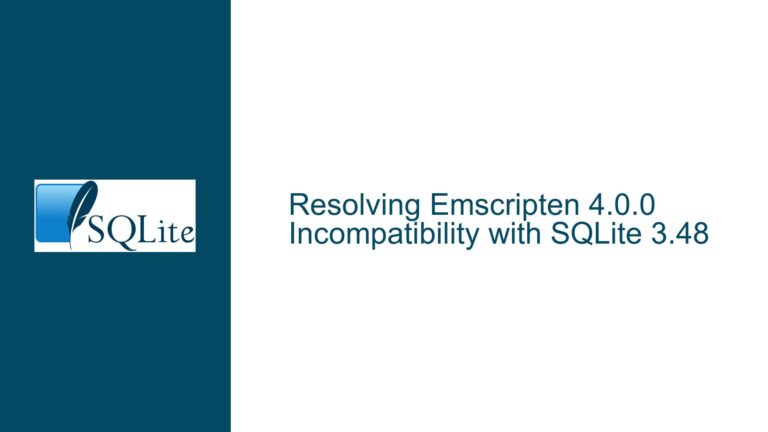Scaling SQLite-Based Comment Systems with Marmot, Isso, and Fly.io: Replication Conflicts, Latency, and Deployment Challenges
Integrating Marmot’s Replication with Isso’s SQLite Backend in Distributed Fly.io Environments
Issue Overview
The core challenge revolves around deploying Isso—a lightweight SQLite-based commenting system—on Fly.io’s horizontally scalable infrastructure while using Marmot to replicate SQLite databases across nodes. SQLite, by design, is a single-node embedded database lacking native horizontal scaling capabilities. Marmot addresses this by introducing log-based replication, but integrating it with Isso (which assumes a single-writer SQLite instance) introduces complexities. Fly.io’s ephemeral containers and global distribution amplify these challenges, as nodes may experience network partitions, replication lag, or conflicting writes.
Key technical friction points include:
- Write Conflict Propagation: Isso’s REST API endpoints handle comment creation, moderation, and updates. Under concurrent traffic, multiple Fly.io nodes may attempt simultaneous writes to their local SQLite instances via Marmot. Without a consensus mechanism (e.g., RAFT or Paxos), Marmot’s asynchronous replication can lead to divergent database states.
- Schema Synchronization Delays: Marmot replicates SQLite’s write-ahead log (WAL), but schema changes (e.g., Isso’s
commentstable migrations) require coordinated locking. If a Fly.io node initiates a schema change while others are offline, partial replication can corrupt the WAL. - Fly.io’s Ephemeral Storage: Fly.io containers restart frequently, and unless Marmot’s replicated logs are persisted to durable storage, nodes risk losing un-replicated data. Isso’s client-facing API may return inconsistent comment threads if queries hit nodes with stale replicas.
- Clock Skew and Conflict Resolution: Timestamp-based conflict resolution (common in distributed SQLite setups) fails when Fly.io nodes’ clocks drift. Isso relies on
createdtimestamps for comment ordering, which may misorder comments if clocks are unsynchronized.
Root Causes of Replication Inconsistencies, Node Starvation, and Client-Side Glitches
1. Marmot’s Asynchronous Replication Model
Marmot operates by tailing SQLite’s WAL and streaming changes to peers. However, this design prioritizes availability over consistency. If two Fly.io nodes write to the same SQLite database concurrently, Marmot will replicate both WAL entries, but the last writer’s changes may override earlier ones without application-level conflict detection. Isso, unaware of replication dynamics, assumes a linearized history of comments, leading to phantom reads or disappearing posts during network hiccups.
2. Uncoordinated Schema Migrations
SQLite schema modifications (e.g., ALTER TABLE) require an exclusive lock. Marmot’s replication layer doesn’t coordinate schema locks across nodes. Suppose a migration is applied on Node A while Node B is offline. When Node B reconnects, it may apply the schema change mid-replication, violating SQLite’s lock hierarchy and crashing the replication process.
3. Fly.io’s Network Topology and Transient Nodes
Fly.io dynamically schedules containers across regions. A Marmot node in us-east may replicate to a node in eu-west, but high-latency links delay log propagation. Clients routed to different regions via Fly.io’s Anycast may observe outdated comments. Additionally, Fly.io’s 30-second default graceful shutdown period may truncate Marmot’s replication buffer, causing data loss.
4. Isso’s Stateless HTTP API and Connection Pooling
Isso’s Flask-based API doesn’t enforce sticky sessions. A user posting a comment may hit Node A, which acknowledges the write, but subsequent reads may route to Node B, which hasn’t received the replication update. While Marmot eventually synchronizes nodes, the user perceives a “comment not found” error. Isso’s SQLite connection pool may also exhaust file handles under load, blocking replication threads.
Mitigating Replication Lag, Enforcing Schema Safety, and Optimizing Fly.io Deployment
Step 1: Configure Marmot for Stronger Consistency
- Enable Synchronous Replication: Adjust Marmot’s
replication_modetoSYNCinstead ofASYNC. This forces the local node to await acknowledgment from a quorum of peers before confirming writes to Isso. While this increases latency, it reduces the risk of divergent states. - Quorum Requirements: Set
--replication-quorum=2(assuming a 3-node cluster) to ensure writes propagate to at least one other node before returning success to Isso.
Step 2: Implement Application-Level Conflict Resolution
- Vector Clocks for Comment Ordering: Augment Isso’s
commentstable with Lamport timestamps or hybrid logical clocks. Each comment insertion increments a node-specific counter, allowing deterministic conflict resolution during replication. - CRDTs for Moderations: Model comment moderation (e.g., deletions, flags) as conflict-free replicated data types (CRDTs). For example, a tombstone marker with a timestamp ensures deletions propagate correctly even if reordered with updates.
Step 3: Schema Change Coordination
- Pre-Deploy Migration Locks: Before running Isso schema migrations, drain Fly.io nodes to a single instance using
fly scale count 1. Apply the migration, then restart the cluster. Marmot will propagate the schema change before accepting new writes. - Versioned Schema Checks: Add a
schema_versiontable to SQLite. On startup, each Marmot node checks its local version against peers. Mismatches trigger an alert, halting replication until an admin resolves the discrepancy.
Step 4: Fly.io-Specific Optimizations
- Persistent Volumes for WAL Storage: Mount Fly.io volumes to
/var/lib/marmotto retain WAL files across container restarts. Configure Marmot’ssnapshot_intervalto 5 minutes, ensuring frequent backups to mitigate data loss. - Regional Affinity with Fly.io Groups: Deploy Fly.io node groups per region (e.g.,
europe,north-america) and configure Marmot to prioritize intra-group replication. Use Fly.io’sprimary_regionto pin write traffic to a single group, reducing cross-region latency.
Step 5: Client-Side Retries and Caching
- Exponential Backoff in Isso Clients: Modify Isso’s JavaScript client to retry failed comment submissions with jittered delays. Include a
X-Marmot-Epochheader in API responses to let clients detect node switches. - Edge Caching with Fly.io’s CDN: Cache read-only endpoints like
GET /commentsat Fly.io’s edge. SetCache-Control: max-age=10to tolerate 10 seconds of replication lag while serving stale comments temporarily.
Step 6: Monitoring and Alerts
- Prometheus Metrics for Marmot: Expose Marmot’s replication lag metrics (e.g.,
marmot_replication_lag_ms) via Prometheus. Configure Fly.io alerts to trigger when lag exceeds 5000 ms. - Log Correlation with Loki: Use Grafana Loki to aggregate logs from Marmot, Isso, and Fly.io’s load balancer. Trace a comment’s journey from POST request through WAL replication using a shared
trace_id.
Step 7: Testing Under Partition Scenarios
- Chaos Engineering with Fly.io: Use
fly proxyto simulate network partitions between regions. Verify that Marmot pauses replication and Isso returns 503 errors during partitions, avoiding split-brain scenarios. - Load Testing with Realistic Traffic: Replay Isso’s HTTP traffic using
wrkorvegeta, varying write/read ratios. Monitor Marmot’swal_buffer_sizeto detect memory pressure from unbounded replication queues.
By addressing Marmot’s replication semantics, Fly.io’s operational constraints, and Isso’s SQLite integration layer methodically, developers can achieve a horizontally scaled commenting system with eventual consistency and minimal client-facing disruptions.






